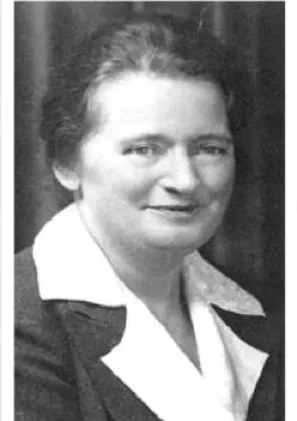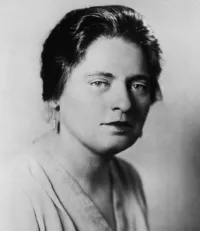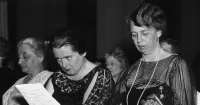Biography
1893 - 1968
"I’ve been trying to bring back your face — to remember just how you look. Funny how even the dearest face will fade away in time. Most clearly I remember your eyes, with a kind of teasing smile in them, and the feeling of that soft spot just north-east of the corner of your mouth against my lips."
- Lorena Hickok letter to Eleanor Roosevelt in 1933
Lorena Hickok stormed the male-dominated world of journalism, working for papers in the Midwest and New York before becoming one of the first women to have a byline with the Associated Press. In 1933, as chief investigator for the Federal Emergency Relief Administration, her detailed, insightful reports were read by President Franklin Roosevelt. After 1936 she did promotional work for the 1939 World’s Fair and the Democratic National Committee. Her 20-year career as a nationally syndicated reporter was cut short when her close friendship with Eleanor Roosevelt led to suspicions that she could no longer be objective in her writing. As a result Hickok’s considerable accomplishments have often been overshadowed by her 30-year relationship with the First Lady, whom she called “ER,” and the extraordinary access to the President it provided. (Indeed, from 1940 to 1944, Hickok, herself, dwelt primarily at the White House) Though many of the letters the First Lady and Hickok exchanged were destroyed (by Hickok) in an effort to conceal the intimacy of their relationship, the more than 2,300 that survive include hundreds of examples of this particularly sensitive correspondence, all of which are now preserved at the FDR Library. Hickok wrote several biographies geared towards young readers including The Story of Helen Keller (1958) and two about Eleanor. The two women collaborated on Women of Courage, a portrait of women political leaders. Hickok moved to Hyde Park, New York to remain near the former First Lady after FDR’s death. She died from complications due to diabetes in 1968.
1893 - 1968
"I’ve been trying to bring back your face — to remember just how you look. Funny how even the dearest face will fade away in time. Most clearly I remember your eyes, with a kind of teasing smile in them, and the feeling of that soft spot just north-east of the corner of your mouth against my lips."
- Lorena Hickok letter to Eleanor Roosevelt in 1933
Lorena Hickok stormed the male-dominated world of journalism, working for papers in the Midwest and New York before becoming one of the first women to have a byline with the Associated Press. In 1933, as chief investigator for the Federal Emergency Relief Administration, her detailed, insightful reports were read by President Franklin Roosevelt. After 1936 she did promotional work for the 1939 World’s Fair and the Democratic National Committee. Her 20-year career as a nationally syndicated reporter was cut short when her close friendship with Eleanor Roosevelt led to suspicions that she could no longer be objective in her writing. As a result Hickok’s considerable accomplishments have often been overshadowed by her 30-year relationship with the First Lady, whom she called “ER,” and the extraordinary access to the President it provided. (Indeed, from 1940 to 1944, Hickok, herself, dwelt primarily at the White House) Though many of the letters the First Lady and Hickok exchanged were destroyed (by Hickok) in an effort to conceal the intimacy of their relationship, the more than 2,300 that survive include hundreds of examples of this particularly sensitive correspondence, all of which are now preserved at the FDR Library. Hickok wrote several biographies geared towards young readers including The Story of Helen Keller (1958) and two about Eleanor. The two women collaborated on Women of Courage, a portrait of women political leaders. Hickok moved to Hyde Park, New York to remain near the former First Lady after FDR’s death. She died from complications due to diabetes in 1968.
Demography
Demography
Gender Female
Sexual Orientation Lesbian
Gender Identity Cisgender
Ethnicity Caucasian/White
Nations Affiliated United States
Era/Epoch First-wave Feminism (1848-1930) Great Depression (1929-1939) Roaring Twenties (1920-1929) World War II (1939-1945)
Field(s) of Contribution
Author
Journalism
Politics
Social Justice
Commemorations & Honors
Franklin D. Roosevelt Presidential Library and Museum in Hyde Park Houses Lorena Hickok's Letters
Associated Press Award For Best Feature Story of the Month About President Warren G. Harding’s Funeral Train (1923)
Demography
Gender Female
Sexual Orientation Lesbian
Gender Identity Cisgender
Ethnicity Caucasian/White
Nations Affiliated United States
Era/Epoch First-wave Feminism (1848-1930) Great Depression (1929-1939) Roaring Twenties (1920-1929) World War II (1939-1945)
Field(s) of Contribution
Author
Journalism
Politics
Social Justice
Commemorations & Honors
Franklin D. Roosevelt Presidential Library and Museum in Hyde Park Houses Lorena Hickok's Letters
Associated Press Award For Best Feature Story of the Month About President Warren G. Harding’s Funeral Train (1923)
Resources
Resources
Baker, Russell "The Charms of Eleanor". The New York Review of Books, June 9, 2011.
Bloom, Amy. White Houses. New York: Random House, 2019.
Cerrito, Joann. "Eleanor Roosevelt." Gay & Lesbian History. Michael J. Tyrkus, ed. Detroit: St. James, 1997. 379-82.
Faderman, Lillian, Odd Girls and Twilight Lovers: A History of Lesbian Life in Twentieth-Century America, Penguin Books Ltd, 1991.
Streitmatter, Roger, ed. Empty Without You: The Intimate Letters of Eleanor Roosevelt and Lorena Hickok. New York: The Free Press, 1998.
http://en.wikipedia.org/wiki/Lorena_Hickok
http://www.huffingtonpost.com/michelangelo-signorile/the-roosevelts-ken-burns_b_5866998.html
http://www.brainpickings.org/2012/10/11/eleanor-roosevelt-lorena-hickok-love-letters/
http://www.sfgate.com/performance/article/Hick-an-intimate-look-at-Eleanor-Roosevelt-s-5597169.php
https://www.pride.com/who-f/2014/07/10/who-f-%e2%80%a6-journalist-lorena-hickok
Resources
Baker, Russell "The Charms of Eleanor". The New York Review of Books, June 9, 2011.
Bloom, Amy. White Houses. New York: Random House, 2019.
Cerrito, Joann. "Eleanor Roosevelt." Gay & Lesbian History. Michael J. Tyrkus, ed. Detroit: St. James, 1997. 379-82.
Faderman, Lillian, Odd Girls and Twilight Lovers: A History of Lesbian Life in Twentieth-Century America, Penguin Books Ltd, 1991.
Streitmatter, Roger, ed. Empty Without You: The Intimate Letters of Eleanor Roosevelt and Lorena Hickok. New York: The Free Press, 1998.
http://en.wikipedia.org/wiki/Lorena_Hickok
http://www.huffingtonpost.com/michelangelo-signorile/the-roosevelts-ken-burns_b_5866998.html
http://www.brainpickings.org/2012/10/11/eleanor-roosevelt-lorena-hickok-love-letters/
http://www.sfgate.com/performance/article/Hick-an-intimate-look-at-Eleanor-Roosevelt-s-5597169.php
https://www.pride.com/who-f/2014/07/10/who-f-%e2%80%a6-journalist-lorena-hickok





